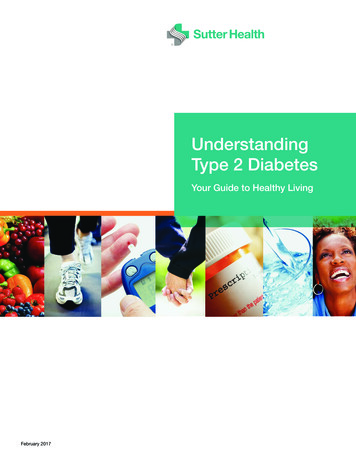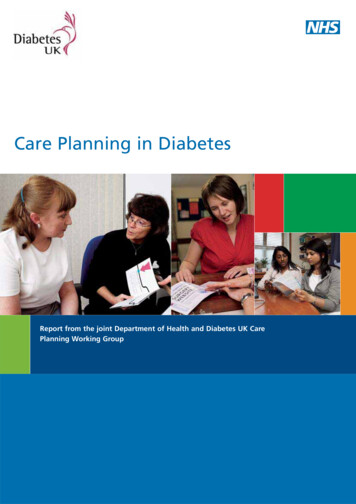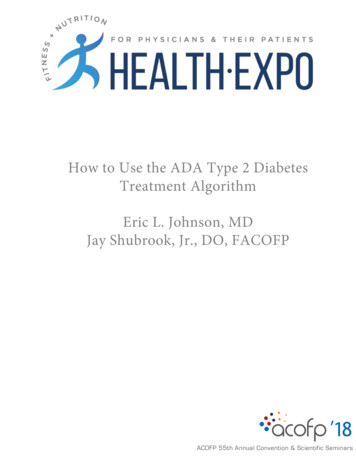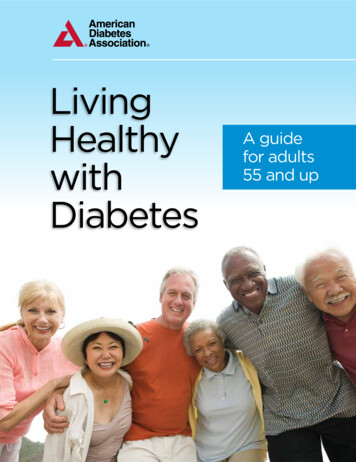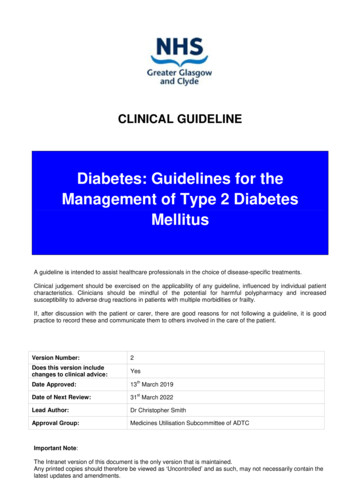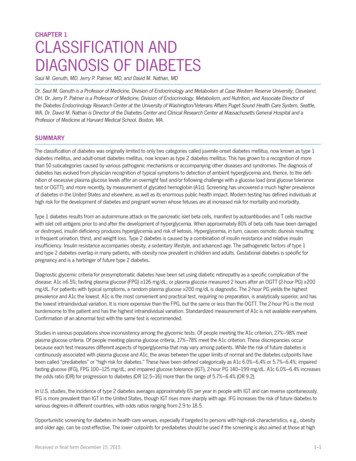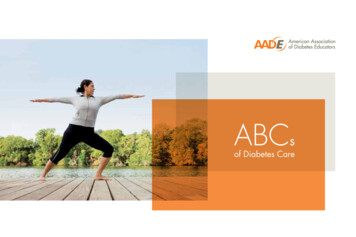
Transcription
ABCsof Diabetes Care
Staying healthy when you have diabetes can be challenging. But themore you focus on the positive results of a healthy diet, medicationroutine and regular exercise, the easier it will be to keep your bloodglucose, blood pressure and cholesterol in good control.This booklet will help you understand three parts of your diabetesmanagement and the self-care behaviors that will help meet yourhealth goals in each area. It’s as easy as learning your ABCs!By knowing and controlling your A (A1C), B (Blood Pressure), and C (Cholesterol),you can stay healthy, achieve your goals, and live well with diabetes.
What are the ABCs?A is for A1CA1C is a blood test that measures an individual’s average blood sugar or blood glucose levels overthe last 2–3 months. A1C is a percentage, often ranging from 4-12. High A1C results put you at riskfor future health problems.Another way to express this average is called estimated average glucose (eAG). The difference is that it’swritten in mg/dL (the same number you see when you check your blood glucose on your home monitor)instead of a percentage.Your healthcare provider will work with you to set an A1C/eAG goal specifically for you. However, theAmerican Diabetes Association recommends that most people with diabetes aim for an A1C of less than7.0 (eAG of 154) and the American Academy of Endocrinologists and the American Association ofDiabetes Educators (AADE) recommend an A1C of 6.5 or lower (eAG of 140). This will help youremain healthy and reduce your risk for complications of diabetes.My A1CMy Goal A1C
B is for Blood PressureBlood pressure—As your heart pumps blood through yourbody, pressure is applied to the inside walls of your blood vessels.If you have high blood pressure, your heart is working harderthan it should— and this can cause health problems.Blood pressure is easily measured at the doctor’s office or witha home blood pressure monitor. For most people with diabetes,blood pressure should be less than 130/80mmHg. High bloodpressure increases your risk for stroke, heart attack and kidneydisease. It is important to take action to get your blood pressurein control.My Blood PressureMy Goal Blood Pressure
C is for CholesterolCholesterol is a form of fat that can build up in your blood, putting you at anincreased risk for heart attacks and strokes. It has three parts that can be measured:low density lipoproteins or LDL, high-density lipoproteins or HDL, and triglycerides.Levels of LDL, the “bad” cholesterol, that are too high can lead to a buildup ofcholesterol in your arteries. HDL, or “good” cholesterol, helps remove cholesterolfrom your blood. High triglycerides (a form of fat that floats in the blood along withcholesterol) may increase your risks as well. It’s important that all parts of yourcholesterol are within healthy levels.For most people with diabetes, cholesterol goals are:LDL – less than 100 mg/dLHDL – greater than 40 mg/dL for men and 50 mg/dL for womenTriglycerides – less than 150 mg/dL
Be sure to discuss your individual cholesterol goals with your care team.My Current Levels(mg/dL)LDLHDLTriglyceridesMy Goal Levels(mg/dL)
AADE7 Self-Care BehaviorssevenThe American Association of Diabetes Educators has identifiedself-care behaviors, called the AADE7 that will help you manage your bloodglucose, blood pressure and cholesterol—and live a healthier life with diabetes.TM1Healthy EatingIf you have diabetes, you do not have to giveall three types, but it is especially important to controlup your favorite foods. But you will need to paythe amount of carbohydrates you eat because theyattention to how much you eat, when you eat,raise your blood glucose more than the other two.and what effect food has on your health goals.Carbohydrates are foods such as: bread, rice,How can what you eat affect your ABCs?pasta, fruits, cereals, grains, starchy vegetablesA1C: The types of food you eat, how much and(like potatoes, corn, squash and dry beans), candy,when you eat them all affect the amount of glucosecookies, baked goods and sweet beverages. All ofin your blood. By learning to eat regular meals,these foods have an effect on your blood glucose.making healthy food choices, watching your portionsizes, and monitoring your blood glucose levels,you can decrease your A1C/eAG over time!Meats, like poultry, beef and pork, and cheese, aswell as fats and oils and non-starchy vegetableshave very little effect on your blood sugar. Try toThere are three main types of nutrients in food: carbohy balance high carbohydrate-containing foods withdrates, proteins and fats. A healthy meal will includethose that do not contain many carbohydrates.
Blood Pressure: Foods higher in salt (sodium)Cholesterol: Foods high in animal fats (saturatedmay raise your blood pressure. Try to reduce thefats) tend to raise your levels of bad (LDL) cholesterol.sodium in your food choices using these tips:To lower the amount of saturated fat in your meals:nUse herbs and spices to flavor your foodsninstead of adding table salt. Reduce your useof salt (sodium) to no more than 2,300 mg ofsodium each day.nRead food labels to choose foods that are lowerin sodium and added fats. Avoid canned,from chicken before cooking.nnthey are naturally low in sodium.SELF-CHECkWhy is it important to eat healthy meals?What is one thing you can do today that willmake your meals healthier?Choose skim or 1% milk and reduced-fat cheeses.Whole milk and high-fat cheeses have lots ofcholesterol-raising animal fats.generally higher in sodium than fresh foods.Choose vegetables and fruits more often—Use liquid oil in cooking — like canola or olive oil,which are high in healthier mono-unsaturated fats.processed, convenience and fast foods that arenTrim visible fat off of meats and remove the skinnChoose foods high in fiber like whole grain breadsand cereals, fruits and vegetables (leave the peelson). Dry beans and peas are also high in fiber.
2Being ActiveRegular physical activity can help you feel strong,nTry something new. Try yoga, hula hoop,improve your insulin sensitivity, reduce your bloodsalsa dancing, bike riding, or take a class atglucose levels and improve your cholesterol and blooda community center or local gym. If you arepressure. Before you begin, ask your healthcareexercising at home, try exercise DVDs or followprovider to assess your current fitness level and helpalong with exercise shows on television.you set some exercise goals. They don’t have to behuge goals — just adding more physical activitiesto your daily routine will help you stay healthy.Here are some first steps to take:nCreate an activity plan based on your needsnMeasure your progress. keep a record ofyour efforts. Review your short- and long-termaccomplishments to make changes if needed.Reward your achievements and keep yourselfmotivated.and abilities. If you are exercising mainly to loseweight or maintain a healthy weight, increaseyour amount of physical activity and work up to30 minutes a day, 5 days a week.nSELF-CHECkName one activity that you might enjoydoing more often.Recruit a friend, family member or co-worker toexercise with you for support and motivation.nStart moving! Start with something easy like walkingfor 10 minutes a few days a week, and slowlybuild from there. If you have a hard time standingor keeping your balance, try chair, bed or floorexercises to increase your strength and flexibility.What can you do today to get started?
3Monitoringkeeping track of your blood glucose levels andcontinue regularly checking your blood glucoseknowing your other health numbers is important foras recommended by your care team.diabetes management. If glucose monitoring is newto you, talk with your diabetes educator about howand when to check your blood glucose, and what todo when it’s too high or low.Blood Pressure: Be sure your blood pressureis checked at every visit with your care team.If you have high blood pressure, your healthcareprovider may suggest that you take bloodYour ABCs need watching too, and it’s important topressure readings at home in between yourkeep track of your numbers in each area so that youregular appointments.know your target goals and how well you are doing.Cholesterol: This test is done every 6 months to 1A1C: For most people with diabetes, this testyear. It should be part of your annual diabetes check,should be done every 3 – 6 months. Remember toeven if your numbers were previously healthy.SELF-CHECkWhich one of your ABC numbers are you mostWhat can you do today that will help youconcerned about and why?monitor this area of your diabetes care?
4Taking MedicationsThere are several types of medications for peoplewith diabetes—insulin, pills to help manageyour blood sugar, blood pressure medications,cholesterol-lowering medications, and others thatmay work together to help you lower your bloodsugar levels, reduce your risk of complicationsand help you feel better.Medications can be prescribed in each one ofthe ABC areas, but they are only effective if youtake them the correct way and at the right times.It’s important to know the names, doses andinstructions for the medications you’re taking, aswell as the reasons they were prescribed for you.SELF-CHECkDo you ever forget to take yourmedication or skip it on purpose?How can you change this in the future?
5Problem SolvingEveryone encounters problems with their diabetesnMake a sick day plan before you get the flu.control; you can’t plan for every situation you maykeep numbers for your healthcare team handyface. However, there are some problem-solvingin case of emergency.skills that can help you prepare for the unexpected:nWhen you have a special occasion, such asa holiday, wedding, or going out to eat, checkout what will be on the menu. Plan what youwill eat ahead of time.nnMake a plan for situations when alcohol willbe served.nThink of other situations in which you mightfeel out of control. Develop a way to deal withthese ahead of time.If you don’t like to exercise outside during thewinter, explore ways to be active indoors.SELF-CHECkHow have you prepared for the unexpectedWhat can you do to prepare for hypoglycemiain your diabetes management?at home? At work? At a social activity?
6Reducing RisksHaving diabetes increases your chances ofndeveloping other health problems, but you canprevent or delay the onset of complications bykeeping your ABCs within your goal ranges.Visit an eye doctor, called an ophthalmologist,for a dilated eye exam once per year.nTake care of your feet — ask your diabeteseducator for information on foot care procedures.If you have healthy blood pressure and cholesterolYour healthcare provider should do a completelevels, you are less likely to get heart disease.foot exam every year.By paying close attention to your A1C, and takingaction to keep it in a safe range, you can helpnregularly. Report any results out of your goalkeep your eyes, feet and kidneys healthy.To help reduce your risk of complications:nDon’t smoke — if you do, seek help in quitting.nSee your care team on a regular basis —usually every 3 – 6 months.Check your blood sugar and blood pressurerange to your care team.nVisit your dentist twice a year and rememberto brush at least twice a day and to floss yourteeth daily.nHave your cholesterol and A1C checked regularly.SELF-CHECkLook at the list above. Which one of theseWhat is one thing that you can do todaythings do you have trouble doing?to reduce your risks?
7Healthy CopingDiabetes can affect you physically and emotionally.nDo something physical. Physical activity canIt is natural to have mixed feelings about yourpositively influence your mood. If you are sad,diabetes management and experience emotionalanxious, stressed or upset, go for a walk, standhighs and lows.up and stretch, take a bicycle ride or do anythingThat’s what healthy coping is all about—findingways to acknowledge those negative feelings anddeal with them in a way that will help you stay onyou can to move your body more — even in achair. Exercise actually increases the chemicalsin your brain that help make you feel good!track, or get back on track.Here are some strategies to help you cope withthe tough times in your diabetes self-management:nSELF-CHECkHow can you deal with stress in a positive way?Develop a support network. Be sure to developand nurture relationships in your personal life.nGo to group educational or support sessionsList three activities you enjoy doing that help you relax.where you can meet and relate to other peoplegoing through the same experiences.nTalk to your doctor or educator if you feel downoften, have changes in appetite or sleep, anddon’t feel like taking care of yourself.nDo things that you enjoy — garden, talk withfriends, read.123
200 West Madison StreetSuite 800Chicago, IL sored by a grant from Novartis Pharmaceuticals Corporation
What are the ABCs? A is for A1C A1C is a blood test that measures an individual’s average blood sugar or blood glucose levels over the last 2–3 months. A1C is a percentage, often ranging from 4-12. Hig



